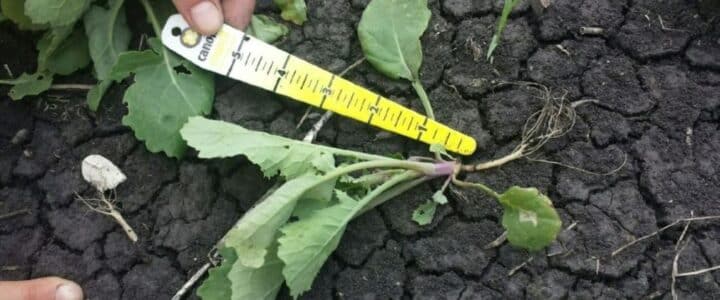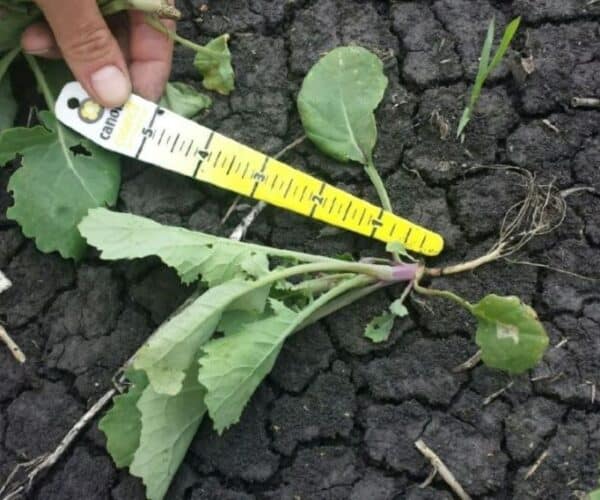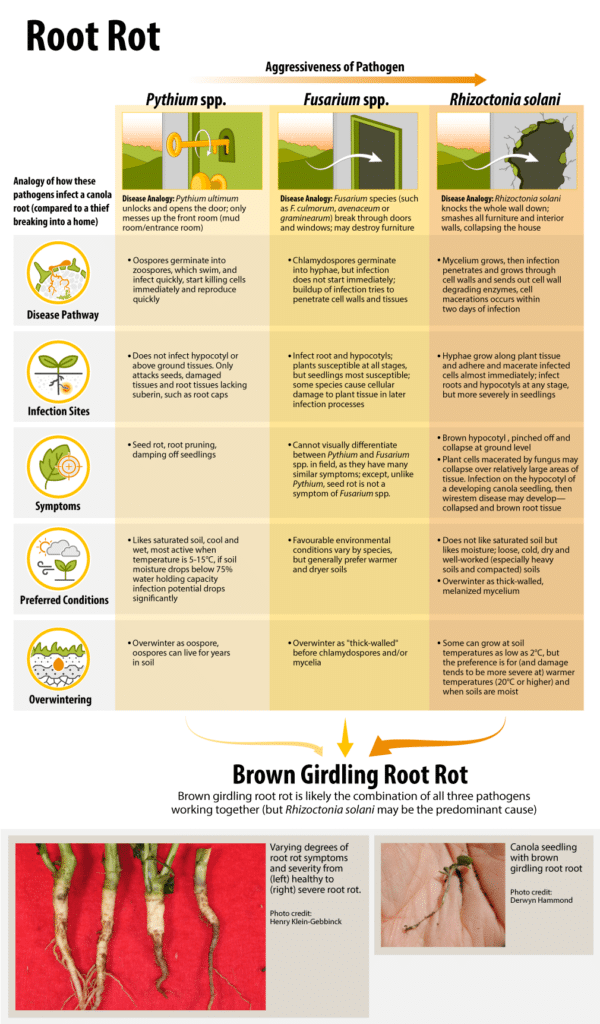Canola is vulnerable to a number of seed and seedling diseases, including those caused by Rhizoctonia solani, Fusarium species and Pythium species (see ‘Comparison of root rot pathogens’ graphic below). These can impact plant survival and subsequent plant and establishment and populations. In addition to effective scouting at the right time, research has been done on the soil pathogen populations and preventative or operational practices to better manage these diseases.
Investigating crop rotation impacts
Dr. Sheau-Fang Hwang’s Effect of crop rotation on canola seedling blight and soil pathogen population dynamics project investigated the consequences of intensive rotations on seedling emergence and other plant growth parameters, as affected by soil pathogens and soil population dynamics.
Soil samples were collected for pathogen inoculum sources from field plots with various crop rotation histories, at Scott and Melfort, SK after the cropping season in 2006 and from Scott, SK, in 2007. This inoculum was then used in the field experiments, which were four replicated split-plots with seven rotations as treatments (Table 1), with all phases of each rotation present every year. Fungicides were applied to sub-plots and 21 composite soil samples were collected from the seven crop rotations.
Improvements from rotation diversity and seed treatments
Results and conclusions from this study include:
- Seedling emergence and other growth parameters were higher in pasteurized soil and when the seeds were treated with fungicide, suggesting that pasteurization and seed treatment reduced the effect of soil pathogens.
- Soil pathogens associated with seedling blight and damping off of canola such as Fusarium, Pythium and Rhizoctonia were abundant in the soils collected from both Melfort and Scott.
- The most abundant of these pathogens were Fusarium species followed by Pythium species, and then Rhizoctonia species.
- Diverse crop rotations are known to reduce the amount of pathogen propagules in the soil, and continuously planting any crop increases diseases and pests specific to that crop, causing a reduction in the yield.
- This study reported that seedling emergence and other growth parameters, including root vigour, shoot weight, root weight, seedling height and plant height were generally greater in the 4-year rotation and comparable among other rotations, although they were not always consistent.
- Similarly, the soil pathogen populations were reduced in the soil following four diverse crop rotations as compared to more intensive rotations.
- Selective increase of crop-specific pathogen populations was also noted in this study.
- For example, the population of Fusarium sp. was consistently higher in soil where pea had been grown continuously, and likewise the population of Pythium sp. was higher under continuous cropping of canola.
Therefore, these management options are recommended:
- Diversify crop rotation to help reduce disease pressure caused by soil-borne pathogens.
- Employ an integrated disease management approach including varietal resistance, other cultural practices and fungicides to manage seedling diseases.
To learn more about this project, see this summary or review the final report.
Factors to reduce canola seedling diseases
Sheau-Fang Hwang’s Reducing seedling blight to improve stand establishment in hybrid canola research further investigated the severe plant population losses due to root rot and seedling blight in canola that many growers deal with. The research team aimed to identify the organisms associated with increased incidence of root rot in canola crops and to improve seedling establishment, seedling vigour and seed yield by optimizing chemical and cultural methods to reduce the impact of seedling blight and root rot on canola seedling populations and yield.
The specific objectives were to:
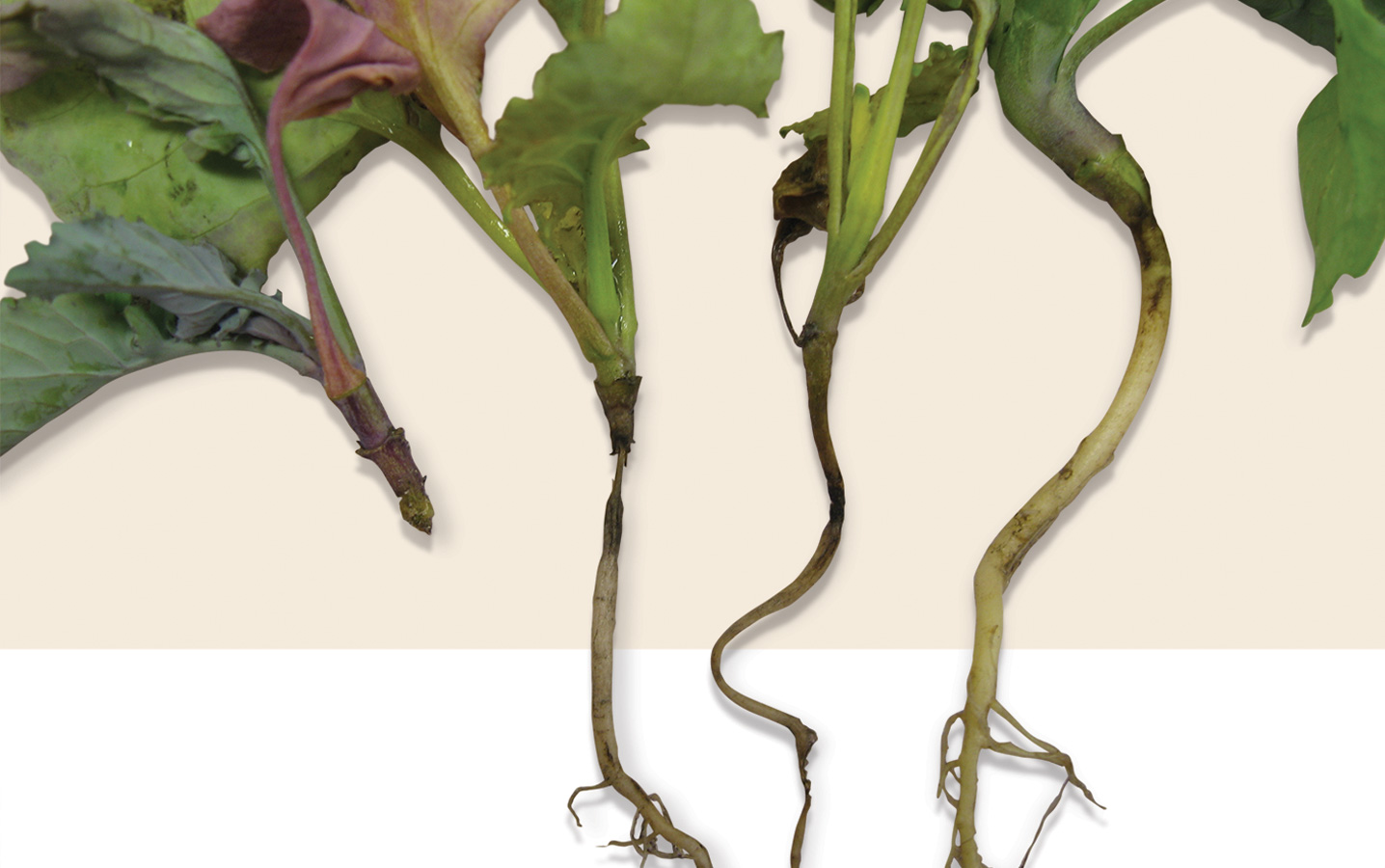
- Conduct surveys and to isolate, culture, identify and assess the virulence of pathogens causing seedling blight of canola under field conditions in Alberta.
- Determine the impact of direct seeding and various residue types on root rot in canola.
- Quantify the effects of the timing of glyphosate application on pathogen populations, canola establishment and root rot severity.
- Determine the impact of inoculum density on seedling establishment and seedling vigour of canola under greenhouse conditions.
- Examine the effect of date of seeding and soil temperatures on susceptibility of canola seedlings to seedling blight and root rot.
- Investigate the effect of seed size on the susceptibility of canola to seedling blight and root rot.
- Determine the effect of seeding depth on the susceptibility of canola to seedling blight.
The research team carried out two field surveys and conducted both greenhouse and small plot field trials between 2007 and 2010 to address these objectives. This allowed for the identification and incidence of pathogens in canola crops and tested the impact of management practices on seedling diseases, which ultimately impacts canola plant stands and subsequent yield.
Seeding date and depth impacts and seed treatment effectiveness


root rot; Photo credit: Hwang’s research team
- The field survey completed in 2008 in central and southern Alberta reported:
- Blackleg was the predominant disease (in 70% of the fields surveyed) followed by fusarium wilt (in 30% fields) and foot rot (in 15% of the fields).
- Fusarium was the predominant pathogen likely causing root rot in canola crops, based on the fields survey completed in 2008 in central and southern Alberta.
- Blackleg was the predominant disease (in 70% of the fields surveyed) followed by fusarium wilt (in 30% fields) and foot rot (in 15% of the fields).
- The 2010 survey led to 100 isolates of Rhizoctonia being purified and utilized in subsequent experiments, which reported:
- Rhizoctonia solani severely reduced canola seedling emergence and yield in both greenhouse and field studies.
- It had greater impact than for either Fusarium or Pythium.
- This pathogen may be responsible for many of the losses experienced by canola producers.
- Rhizoctonia solani severely reduced canola seedling emergence and yield in both greenhouse and field studies.
- Earlier seeding dates had seedlings germinating in cooler, moister soils, which resulted in lower seedling establishment in two of three station years of field data.
- Lower seedling establishment was observed in seeds inoculated for Rhizoctonia, Fusarium and Pythium that were under 0.7 mm in diameter compared to seeds of a larger size.
- Canola seed planted at greater depth showed reduced establishment (in both greenhouse and field studies), though yield was unaffected in the field studies.
- Some fungicide seed treatments reduced seedling blight in Rhizoctonia-inoculated soils, while another fungicide seed treatment was more effective in reducing seedling blight in Fusarium-inoculated soils.
- Treatment effects in Fusarium-inoculated soils varied with the concentration of inoculum and also with canola cultivar.
- Delaying harvest resulted in increased canola seed viability and increased vigour of the resulting seedlings.
Learn more details about this project in the summary, the final report and the resulting publication: The effect of seed size, seed treatment, seeding date and depth on Rhizoctonia seedling blight of canola.
Canola seedling disease resources


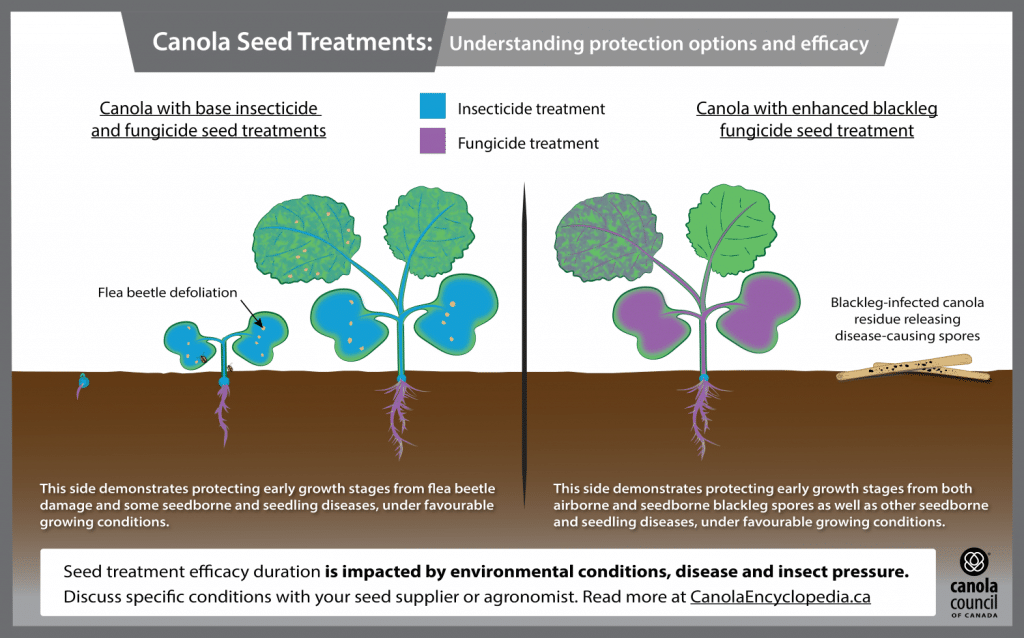

Related canola seedling disease research
More research on factors impacting canola seedling diseases:
- Consequences of phytoplasma infection on canola crop production in the Canadian prairies
- Assessment of seed germination and seedling performance of spring canola at low temperatures
- Improving canola establishment and uniformity across various soil-climatic zones of Western Canada
- Farm gate investigation of best management practices in canola establishment and production systems
- An on-farm approach to monitor and evaluate the interaction of management and environment on canola stand establishment and disease development
Published May 13, 2022


